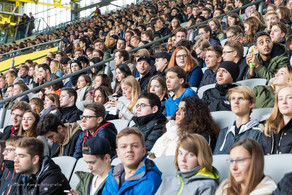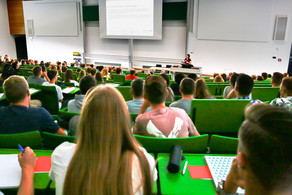Discussion papers SFB 823 in 2015
- 49/15: Holger Dette, Viatcheslav B. Melas, Petr Shpilev
T-optimal discriminating designs for Fourier regression models
- 48/15: Laurie Davies, Walter Krämer
Stylized facts and simulating long range financial data
- 47/15: Nadja Bauer, Klaus Friedrichs, Claus Weihs
Model based optimization of music onset detection
- 46/15: Axel Bücher, Johan Segers
Maximum likelihood estimation for the Fréchet distribution based on block maxima extracted from a time series
- 45/15: Fabian Dunker
Convergence of the risk for nonparametric IV quantile regression and nonparametric IV regression with full independence
- 44/15: Holger Dette, Maria Konstantinou, Anatoly Zhigljavsky
A new approach to optimal designs for correlated observations
- 43/15: Jozef Barunik, Tobias Kley
Quantile cross-spectral measures of dependence between economic variables
- 42/15: Fabian Herrmann
Evaluating the interplay of term premia, monetary policy, and the economy in the euro area
- 41/15: Yannick Hoga, Dominik Wied
Sequential monitoring of the tail behavior of dependent data
- 40/15: Holger Dette, Kirsten Schorning
Optimal designs for comparing curves
- 39/15: Manuel Frondel, Stephan Sommer, Colin Vance
Heterogeneity in residential electricity consumption: A quantile regression approach
- 38/15: Kornelius Kraft
Productivity and distribution effects of codetermination in an efficient bargaining model
- 37/15: Daniel Kobe, Jeannette H.C. Woerner
Oscillating Ornstein-Uhlenbeck processes and modelling of electricity prices
- 36/15: Annika Betken, Martin Wendler
Subsampling for general statistics under long range dependence
- 35/15: Benedikt Funke
Nonparametric drift estimation in a Lévy driven diffusion model
- 34/15: Herold Dehling, Brice Franke, Jeannette H.C. Woerner
Estimating drift parameters in a fractional Ornstein Uhlenbeck Process with periodic mean
- 33/15: Jannis Buchsteiner
The sequential empirical process of nonlinear long-range dependent random vectors
- 32/15: Peter N. Posch, Daniel Ullmann, Dominik Wied
Testing for structural changes in large portfolios
- 31/15: Walter Krämer, Peter N. Posch
Partial orderings of default predictions
- 30/15: Simone Hermann, Katja Ickstadt, Christine H. Müller
Bayesian prediction for a jump diffusion process with application to crack growth in fatigue experiments
- 29/15: Katharina Pape, Dominik Wied, Pedro Galeano
Monitoring multivariate variance changes
- 28/15: Fabian Dunker, Stefan Hoderlein, Hiroaki Kaido
Nonparametric identification of endogenous and heterogeneous aggregate demand models: Complements, bundles and the market level
- 27/15: Srijan Sengupta, Stanislav Volgushev, Xiaofeng Shao
A subsampled double bootstrap for massive data
- 26/15: Kathrin Bissantz, Nicolai Bissantz, Katharina Proksch
Monitoring of significant changes over time in fluorescence microscopy imaging of living cells
- 25/15: Guido Heeke, Simone Hermann, Jens Heinrich, Katja Ickstadt, Reinhard Maurer, Christine H. Müller
Stochastic modeling and statistical analysis of fatigue tests on prestressed concrete beams under cyclic loadings
- 24/15: Manuel Frondel, Colin Vance, Alex Kihm
Time lags in the pass-through of crude-oil prices: Big data evidence from the German gasoline market
- 23/15: Holger Dette, Roman Guchenko, Viatcheslav B. Melas
Efficient computation of Bayesian optimal discriminating designs
- 22/15: Katharina Dyballa, Kornelius Kraft
Does codetermination affect the composition of variable versus fixed parts of executive compensation? - An empirical analysis for listed companies in Germany
- 21/15: Kirsten Schorning, Björn Bornkamp, Frank Bretz, Holger Dette
Model selection versus model averaging in dose finding studies
- 20/15: Paul Kinsvater, Roland Fried, Jona Lilienthal
Regional extreme value index estimation and a test of homogeneity
- 19/15: Mark A. Andor, Manuel Frondel, Stephan Sommer
Reforming the EU emissions trading system: An alternative to the market stability reserve
- 18/15: Michael Hoffmann, Mathias Vetter
Weak convergence of the empirical truncated distribution function of the Lévy measure of an Ito¯semimartingale
- 17/15: Walter Krämer, Dominik Wied
A simple and focused backtest of value at risk
- 16/15: Herold Dehling, Roland Fried, Martin Wendler
A robust method for shift detection in time series
- 15/15: Olimjon Sh. Sharipov, Johannes Tewes, Martin Wendler
Bootstrap for U-Statistics: A new approach
- 14/15: Holger Dette, Kathrin Möllenhoff, Stanislav Volgushev, Frank Bretz
Equivalence of dose response curves
- 13/15: Christine H. Müller, Sebastian Szugat, Nuri Celik, Brenton R. Clarke
Influence functions of trimmed likelihood estimators for lifetime experiments
- 12/15: Axel Bücher, Paul Kinsvater, Ivan Kojadinovic
Detecting breaks in the dependence of multivariate extreme-value distributions
- 11/15: Mark A. Andor, Manuel Frondel, Colin Vance
Mitigating hypothetical bias: Evidence on the effects of correctives from a large field study
- 10/15: Carina Gerstenberger, Daniel Vogel
On the efficiency of Gini's mean difference
- 09/15: Dominik Wied, Gregor N.F. Weiß, Daniel Ziggel
Evaluating value-at-risk forecasts: A new set of multivariate backtests
- 08/15: Holger Dette, Weichi Wu, Zhou Zhou
Change point analysis of second order characteristics in non-stationary time series
- 07/15: Christian Bredemeyer, Falko Juessen, Roland Winkler
Man-cessions, fiscal policy, and the gender composition of employment
- 06/15: Tobias Liboschik, Konstantinos Fokianos, Roland Fried
tscount: An R package for analysis of count time series following generalized linear models
- 05/15: Alexander Schnurr, Herold Dehling
Testing for structural breaks via ordinal pattern dependence
- 04/15: Simone Hermann, Katja Ickstadt, Christine H. Müller
Prediction of crack growth based on a hierarchical diffusion model
- 03/15: Ludger Linnemann, Roland Winkler
Estimating nonlinear effects of fiscal policy using quantile regression methods
- 02/15: Manuel Frondel, Stephan Sommer, Colin Vance
The burden of Germany's energy transition: An empirical analysis of distributional effects
- 01/15: Holger Dette, Andrey Pepelyshev, Anatoly Zhigljavsky
Optimal designs in regression with correlated errors






